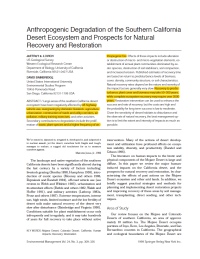Date Published
1999
Summary
Large areas of the southern California desert ecosystem have been negatively affected by off-highway vehicle use, overgrazing by domestic livestock, agriculture, urbanization, construction of roads and utility corridors, air pollution, military training exercises, and other activities.
Reference Information
Lovich, J.E., and D. Bainbridge. 1999. Anthropogenic degradation of the Southern California desert ecosystem and prospects for natural recovery and restoration. Environmental Management 24(3):309-326.


